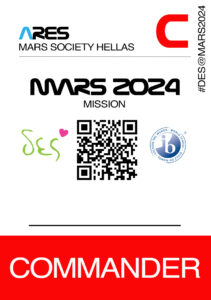DES@Mars 2024
Role: Commander
DES@Mars 2024 is an Interactive Analog Simulation exercise for the elementary school grades. The students acting as astronauts through an holistic experience can test and improve their abilities in STEAM activities, while as in social skills – leadership & team working – each to the common and their own benefit.

Commander, welcome to DES@Mars2024 Mission. Your action tasks are mainly to control the course of the mission where all tasks made on time, mission data (imagery and evidences) sent to NASA Mission Control Center (MCC). Delegate and distribute work ensure that everyone has something to do and is not overburdened.
In case of problems – Organize help, you have to decide what to do in difficult situations.
ACTION TASKS
Task 1: Coordinate with NASA Mission Control Center (MCC) & Team Briefing
- Assure to complete the mission targets and commands received from NASA and brief the station crew team and astronauts for the expedition actions.
Task 2: Confirm Mars Station Team & Astronauts Readiness
- Confirm with the Doctors, Engineers & Scientists if they are ‘CLEAR-TO-GO’.
Task 3: Expedition Monitoring & Reporting
- Follow-up with the expedition for the mission progress by communicating with walkie-talkies asking them for any observations or mission challenges & report to NASA MCC.
The Area

Mission Assessment
The mission success is based on the realisation of all required tasks, timing, motivation of the crew, quality of performed tasks and independence. At the end of the mission, students present their results on the summary meeting. Everyone elaborates the lessons learned. The Assessment takes place by utilizing the following rating model.
NASA 6-Es Rating Model
Each day or section of activities utilizes the 5-E Instructional Model (a constructivist learning cycle, helping students build their own understanding from experiences and new ideas). It has a growing research base and can be used within integration, Problem-based Learning (PBL), Project-based Learning (PjBL), and Universal Design for Learning (UDL). Included in this program guide is a sixth ʻEʼ for Excite. This additional ʻEʼ shows you how to incorporate NASAʼs unique information and resources to excite trainees with career connections, real world examples, spinoffs from NASA research and more.
- Engage: During this stage students are getting interested and personally involved in the lesson, while pre-assessing prior understanding.
- Explore: The purpose for this stage is to get students involved in the topic, providing them with a chance to build their own understanding.
- Explain: At this stage students have the opportunity to communicate what they have learned so far and figure out what it means.
- Elaborate: The purpose for this stage is to allow students to use their new knowledge and continue to explore its implications.
- Evaluate: Here both students and teachers to determine how much learning and understanding has taken place.
ARES
«Εις Άρεα»: «θάρρος χάρισέ μου μακάριε, να κρατιέμαι στους σωτήριους θεσμούς της ειρήνης, αποφεύγοντας τις μάχες με τους εχθρούς μου και τους βίαιους θανάτους».
Πυρόεις
Αφήλιο: 249.209.300 χλμ, (1,665861 AU), Περιήλιο: 206.669.000 χλμ. (1,381497 AU), Ημιάξονας τροχιάς: 227.939.100 χλμ. (1,523679 AU), Εκκεντρότητα: 0,093315, Περίοδος περιφοράς: 686,971 ημέρες, (1,8808 έτη), Συνοδική περ. Περιφοράς: 779,96 ημέρες (2,135 έτη), Μέση τροχιακή ταχύτητα: 24,077 χλμ./δευτ. 86.677,2 χλμ./ώρα, Μέση ανωμαλία: 19,3564°, Κλίση τροχιάς: 1,85061°(ως προς την Εκλειπτική) 5,65°(ως προς τον Ηλιακό ισημερινό), Δορυφόροι: 2 φυσικοί (Φόβος, Δείμος)

